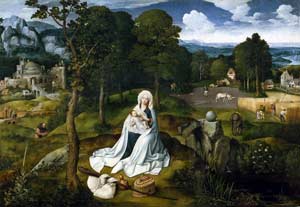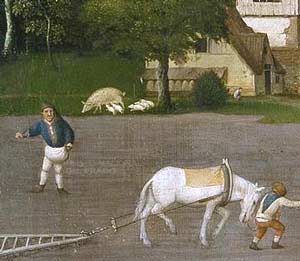Flemish, (c. 1480-1524)

-
Rest During the Flight into Egypt
- (cc. 518 – 1520), oil on panel
- 47.6 x 69.7 in. (121 x 177 cm.)
- Museo del Prado, Madrid
-
Editor’s Note:
The iconography in this work is varied. The Virgin, sits on a rock, with the Child in her lap, finding relief to the weariness of the road while Saint Joseph, to the left, is coming toward them carrying a jug of milk.
The composition is completed with other unusual scenes from various apocryphal texts. These include the fantastic architectural elements and the feet of a sculpture on a sphere that allude symbolically to the episode known as The Fall of Idols. And, to the right, peasants working in the fields are a reference to the Miracle of the Field of Wheat, when Jesus made the grain grow to put the soldiers following Mary and Joseph off their track.
The exact meaning of another suckling mother – the sow and her piglets is obscure. Much iconography of this time period has been lost to modern scholars. It is also possible that the sow and piglets are mere ornamentation – a common and expected sight in a real rural landscape of this time.
Here is a close-up of the sow.

About the Artist
Joachim Patinir, Flemish, (c. 1485-1524). Patinir was a pioneer of the landscape as an independent genre in western art. He was the first artist to attach the main role to nature in his compositions. His style is a combination of naturalistic observation of detail and a marvelous sense of fantasy.
Although landscape never constitutes the subject of Patinir works, it is the core of his work where his small-sized religious and mythological figures take on a more subordinate role.
Almost nothing is known of Patinir’s early life and training. In 1521 he met Dürer, who made a drawing of him and described him as a “good landscape painter”. Very few signed paintings of Patinir’s exist today, while many others have been attributed to him with varying degrees of probability.
